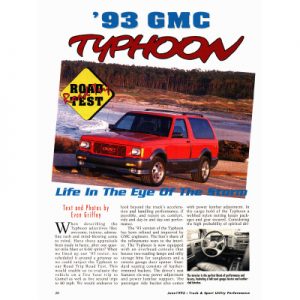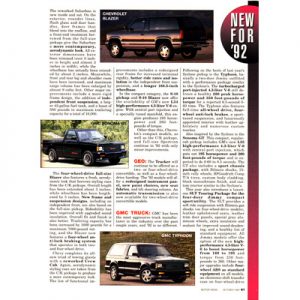Car Audio and Electronics

People who consider a car simply a means of getting from point A to point B might find it hard to imagine the thrill of owning a high-performance vehicle. But for the owner of a muscle car with a bigblock engine, or a turbocharged sports car with 250 horsepower, driving is an adventure.
Look into Grant Schermer’s garage and you can tell what group he kills into. Inside you’ll find a ’68 Plymouth Fury III convertible, a 91 Chevrolet Corvette ZR-I , an ’87 Buick Grand National and a ’92 GMC Typhoon.
“I really like performance vehicles,” said the 36-year-old land developer, adding that the mountains around his home in Missoula, Montana, heighten the pleasure of driving. Schermer is also co-owner of Street Sounds, a car audio store in Spokane, Washington. lie bought the limited-production Typhoon intending to install a competition audio system. However, he was determined to preserve the vehicle’s performance. Adding weight reduces the performance of any vehicle. To preserve the power under its hood, the Typhoon was not burdened with unnecessary audio equipment. Ron Anderson, who performed the installation, said component selection was honed down to the essentials for the planned 100-watt system. A former manager at Street Sounds and a friend of Schermer’s, Anderson now works for Quicksilver Audio in Kennewick, Washington.
Spare Sub
The factory appearance of the rear cargo area fools many people, Schermer pointed out. “At almost every competition,” he recalled, “somebody walked up to me and said, ‘Are you going to put a system in this?”’
They don’t realize that the real treasure is tucked away behind panels and inside of a false spare tire.
What looks like a spare tire mounted against the left wall of the cargo area is actually an isobaric subwoofer enclosure. It holds two JL Audio 15W5 15-inch subwoofers, mounted piggyback fashion, with the cone of one subwoofer facing outward.
The enclosure was built out of medium-density fiberboard (MDF) that was soaked in water, bent into a circular shape and allowed to dry. Lined with fiberglass for strength, it replaces the real spare tire and bolts to the same bolt holes.
The back side of the enclosure opens into a storage compartment formerly occupied by the jack. This compartment provides extra air space for the subwoofers; it was lined with fiberglass for a tight seal.
Adding the subwoofer enclosure didn’t result in any net weight gain because the original spare tire and jack assembly were removed.
A black vinyl cover was stitched by Darby Jacobs of Jacobs Upholstery in Spokane. A grille made to look like one of the truck’s factory wheels protects the front woofer’s cone. It was made out of 0.25-inch aluminum cut and engraved to resemble the star pattern on the Typhoon’s wheels. Black grille cloth fills the gaps between the spokes and allows the bass to travel through.
A pocket made out of aluminum and covered in black vinyl was built into the right wall of the cargo area. It holds an Autosound 2000 1-farad capacitor and a fuse. They’re protected by a plexiglas cover and a magnetic door.
Tailgate Trick
Amplifiers and other components are tucked away inside a new tailgate. (The original was removed and stored away) “We can bolt it right back on,” said Anderson, adding that he planned the installation so the Typhoon can be returned to its stock appearance. The new tailgate was painted on the outside and trimmed in black vinyl on the inside to match the original. After cutting out the inside wall of the tailgate and relocating the latch assembly, Anderson lined the inside with a polished aluminum tray.
“The aluminum was used to carry on a theme from the engine, from the wheels, all the way throughout the inside,” Anderson explained. Besides its durability, the aluminum has the added advantage of being light weight.
Two Phoenix Gold MPS2240 amplifiers arc mounted on the right side of the aluminum tray. They are united by a custom heatsink that makes them look like one amplifier.
A Phoenix Gold TBA-1 receiver is mounted on the top left corner. Next to it is a Phoenix Gold AX204A electronic crossover. Passive crossovers that further break down the signal going to the tweeters and midrange speakers are mounted on the bottom left corner of the tray. In the center are slave units for a Clark Audio 823-A noise gate and power-distribution and fuse blocks.
A blue tinted plexiglas panel covers the equipment in the tailgate. A motorized lid made of aluminum covers the plexiglas panel. The inside of the lid was lined with gray cloth to protect the plexiglas, and black vinyl covering the outside was stitched with the Typhoon logo to match the original tailgate. The motorized lid is controlled by a switch located on the pocket that holds the capacitor.
You Can Stomp On It
Anderson used factory speaker locations in the dash for two MB Quart 100/19 4-inch midranges, one on each side. The speaker cut-out was lined with Dynamat and lambs’ wool. Anderson said the Typhoon’s grilles were also modified to make sure the output from the speakers wasn’t constricted. They were covered in black grille cloth.
Infinity EMIT-N Kappa tweeters are angle-mounted inside fiberglass pods attached to the front window pillars. To make the pillars and pods look like one piece, Anderson wrapped them with gray vinyl. Black fabric grilles cover the tweeters.
Lacking factory speaker locations in the doors, Anderson built a fiberglass pod on each kick panel to hold an MB Quart QM 160 TX 6.5-inch midrange mounted on an MDF baffle. The pods were covered with gray carpet and the original grilles cover the speakers.
Custom panels made out of molded fiberglass cover the pods, with a piece of expanded metal in the center for a grille. Covered in black material to look like ordinary floor mats, they protect the speakers from heavy hoofs. “You can stomp on it,” said Anderson, “and you wouldn’t hurt a thing.”
Rear fill is supplied by an MB Quart QM 19NX tweeter and MB Quart QM 160 TX 6.5-inch midbass speaker in each factory speaker location in the rear side panels. Anderson said the speakers, mounted on MDF baffles, fit in the locations without any cutting. The factory grilles were covered in black cloth to match the other grills in the Typhoon.
Custom Console
A Denon DCC-9770 CD tuner was installed in the factory radio location with a custom-made aluminum trim ring. In the dash below the head unit is the bass level knob for the Phoenix Gold crossover mounted in the tailgate.
Two USD SW30 equalizers are mounted in a custom center console that replaced the original one. (It’s tucked away with the factory tailgate, of course.) The new console was built out of MDF and fiberglass, and wrapped in black vinyl.
It was patterned after the original, including wrapping around the gearshift however, it was extended 3 inches in the rear to accommodate the length of the equalizers. They fit flush in the console, and are trimmed in black vinyl. A hinged door conceals them.
The front of the console extends to the dash. A pocket there holds the transmitter for a Phoenix Gold TBA-1 balanced-line amplifier. Both the TBA- 1 transmitter and the equalizers are covered by blue plexiglas.
The master unit for the Clark Audio noise gate is mounted in the glovebox, protected by a plexiglas cover. Plenty of space remains for storing papers and such.
No Rush
A battery and fuse was added on each side of the truck. They are mounted in compartments welded out of 0.25-inch steel attached to the underside of the Typhoon, in front of the rear tires. The original battery is still located under the hood.
A Phoenix Gold 135-ampere alternator replaced the factory one. Next to it is a Phoenix Gold dual battery isolator.
The installation took eight months to complete, but Schermer didn’t mind. “The car wasn’t rushed,” said Schermer. “It was something where I said, ‘Take as long as you want to do it. We’ll go compete when it’s done, but not before that.'”
Schermer’s patience and Anderson’s hard work earned first place in the pro 1-100-watts power class at the 1993 TASCA Finals, Schermer’s first national competition.
“I ran up to the stage and I passed the stairs and just jumped up on the stage, I was so excited,” Schermer recalled.
With updates planned, Schermer is just as excited about the 1994 competition season. But don’t expect them to take any of the wind out of this ride.





